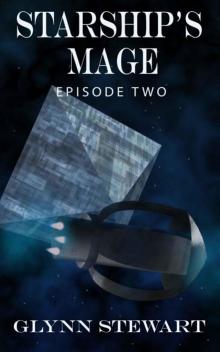- Home
- Glynn Stewart
The Service of Mars Page 4
The Service of Mars Read online
Page 4
“Perfect. Thanks, Davids,” Roslyn told him. It took her a moment to bring up the control protocol, but then she had four drones relaying her data from over ten million kilometers away.
Suicide sweep was exactly what it sounded like. There was enough fuel left in the drones to do a slow and steady return to the fleet—or to do a high-acceleration approach to the enemy with the expectation that they’d be lost to the hostile defenses.
“Samurais launching,” Kulkarni reported behind her. New icons spackled her display, and Roslyn quickly looked up the data on the missiles, incorporating their approach into her timing. She’d get the probes a lot closer if the enemy were focused on the incoming high-speed bombardment missiles.
She finished her programming and leaned back, rubbing her hands together as she double-checked her work. The Samurai’s reduced flight time combined with the time delay meant she had barely enough time to fix the two mistakes she’d made and transmit to the drones, but she wrapped it in time.
The sensor probes lit up their engines at full power moments before the Samurais passed them. They had a “mere” five thousand gravities of acceleration to the big missiles’ thirty thousand, and a lower base velocity as well.
They were stealthier than the Samurais and more maneuverable as well, but the course Roslyn had set them on was going to doom them. The heavy missiles would hopefully buy them a few critical extra seconds.
Lasers and missiles in defensive mode lit up the scanners, and Roslyn waited. Everything she was seeing was still delayed by over forty seconds, and there was nothing she could do to influence the success or failure of her robotic minions.
Out of the corner of her eye, she watched the Samurai salvo charge into the teeth of over sixteen thousand RFLAM turrets. The Republic had clearly updated their targeting programs to account for the new weapons’ speed and acceleration, but they could only do so much about the physical traversal ability of the turrets themselves.
Two dozen missiles made it through and flung themselves into the fortress, antimatter explosions tearing apart the cylindrical hull in a series of cataclysmic detonations.
“Target One destroyed,” Kulkarni reported behind her. “They’re adapting, sir. We probably won’t do as well with the next salvo. They’re still ninety seconds out.”
“We’ll get what we get,” Alexander said calmly. “I’ll settle for hitting all fifteen of them, Kulkarni.”
The data was coming in from the sensor drones, and Roslyn winced as their death codes showed up. The robotic spacecraft had made themselves targets, trying to get the data she’d wanted, and they’d paid for it as expected.
They’d got what she needed. The closest drone had been barely fifty thousand kilometers from the nearest gunship when it was destroyed—close enough for a far more detailed visual than anyone in the fleet could get.
“Sir, take a look at this,” she told Kulkarni. “The gunships are running external engines.”
“They’re what?” she asked.
“All of the gunships have a strapped-on fusion booster engine,” Roslyn explained, sending the imagery to Kulkarni’s screens. “Their engines are still in antimatter mode. They’re trying to make us think they’re in fusion mode.”
“Why would they do that?” her superior asked.
“We’re assuming they’re low on antimatter,” Roslyn suggested. “If they were, they wouldn’t be spending it on gunships—but if those gunships were running on fusion drives, they’d have burned a good chunk of their available delta-v in their defensive maneuvers.”
“Where instead, they’ve burned out a temporary rocket and still have their full antimatter storage,” Kulkarni agreed. “And if they’ve got the antimatter to fuel their gunships…”
“They’ve got the antimatter to fuel their missiles and not worry about expending them,” Roslyn told her. “I don’t know if that changes the plan, sir, but I think we need to consider it.”
“We do,” the other woman said. “We truly do. Well done, Lieutenant.”
Kulkarni turned her attention away.
“Admiral Alexander, Mage-Lieutenant Chambers has picked up an interesting layer to our Republic friends’ maneuvers,” she told the Admiral. “Those gunships are set up in antimatter mode and faking being fusion-driven. The external boosters are probably even getting in the way of their defensive fire.”
Missiles hammered into a second fortress as they spoke. This one survived—barely. From its power signature, Roslyn didn’t expect it to be participating much in the battle to come.
“That’s a lot of effort to fool us on something small, Kulkarni,” Alexander said. She paused. “Except that they want to let us keep thinking they’re short on antimatter. Fascinating.”
There were several seconds of silence as the Mage-Admiral considered the situation, then Alexander shook her head.
“Chambers, get me an all-Captains channel,” she ordered.
Roslyn had a pre-coded program sitting in her console for that. She hit it, confirmed it had worked, then looked up at the Admiral.
“You’re on, sir.”
“Everyone, this is Admiral Alexander,” the fleet commander said calmly. “Our Republican friends are playing games to conceal their true capabilities, and I can only think of one reason they’re doing that.
“Expect to come under fire as we reach launch point bravo. We will continue to reduce the fortresses with the Samurais, but I suspect we’ve taken too long to bring the war to the Republic. Our general range advantage may already be gone, but we still have options they don’t.”
Roslyn hadn’t even thought of that possibility. Neither, she suspected, had most of the Captains and flag officers, from the tone of their acknowledgements.
“Kulkarni, let’s get the destroyers a bit more spread out,” Alexander ordered after a moment. “Formation Romeo-Seven, I think.”
“Understood.”
R-7, if Roslyn remembered it correctly, would interlace the Cataphracts and their augmented missile defenses with the older ships. It would also move the destroyers forward in the fleet formation, putting them at the greatest risk.
The theory was that the destroyers were low-value targets that the Republic would try to shoot past, but it was a theory that could result in a lot of wrecked destroyers if Admiral Alexander guessed wrong.
Another salvo of Samurais tore through the Republic fortresses as the destroyers maneuvered through Second Fleet’s formation. This time, the targeted fortress vanished from the displays as antimatter tore it apart. From this distance, Roslyn couldn’t say if the RIN had failed to stop as many missiles as the previous salvos or if the RMN had scored a lucky hit, but it hardly mattered.
“That’s three fortresses destroyed and four badly damaged or crippled,” Kulkarni reported. “Three salvos still en route. Should we reassess targeting, sir?”
“No,” Alexander said grimly. “Those forts are likely more heavily armed than the cruisers, but their limited mobility makes them easier targets, especially for long-range weapons like the Samurais.”
Durendal shivered beneath them as the hammerhead-mounted bombardment-missile launchers fired again.
“Any change in aspect on our friends?” the Admiral asked.
“Nothing material,” Kulkarni reported. “The gunships have formed up in front of the fleet, but they’re the ones suffering most against the Samurais. Their lasers are too restricted by their physical design to be able to easily track the higher-velocity missiles.”
She shook her head.
“Now that I know they’re there too, I suspect the fusion boosters are hurting their target tracking as well,” she noted. “They aren’t nearly as maneuverable as they’re designed to be.”
And that lack, Roslyn estimated, had killed about fifteen thousand people so far. She shivered as another fortress icon grayed out, long-distance scans suggesting a fifth crippled station.
“Chambers, double-check the sensor data on those cripples,” Alexander
ordered. “If they’re playing games in one place, they might be playing them in others.”
“Yes, sir.”
Roslyn didn’t even need to ask Chief Jian to assist her. The noncom was already pulling the data from Durendal’s sensor suite as the Flag Lieutenant set to work.
“I’m not seeing anything to suggest they’re gaming us,” the Chief told her. “Gas venting, lost energy signatures, the works. They probably have some weapons left, but we’ve hit them hard.”
It took a lot of very carefully designed armor to withstand hits from antimatter weapons, too. The Royal Martian Navy Academy tried to make sure its students understood just how much power they had at their command. A single gigaton-range antimatter warhead was a planet-killer, after all—and even the lightest modern warships would take multiple such hits to breach their armor.
“Get me the data on the active stations as well,” Roslyn ordered Jian. “Just looking at our damaged targets in isolation might not answer the question.”
More data appeared on her screens as the ever-helpful Chief Petty Officer gave her what she needed, and Roslyn stared at the comparison between Target Four, one of their cripples, and Target Sixteen, a station they had never intended to shoot.
The comparison looked right. Target Four had been hit by multiple antimatter warheads, gouging immense holes in her armor and hull. Based off the scans of Target Sixteen, Target Four had lost multiple fusion plants and was nearly helpless.
But something didn’t seem quite right…
Every salvo of Samurais was in space. Every tactical officer in the fleet was busy building firing plans and guiding missiles into their targets. The only people with the time to step back and look at oddities were the Admiral’s staff—and even there, most of Roslyn’s seniors were actively involved in the battle.
If there were an answer here, she was the only one looking at it. She pulled up the data from the four drones she’d sent on their suicide pass and found the visual images of Target Thirteen.
Target Thirteen was being hit by Samurais even as Roslyn dug into the visuals, the most detailed pictures they had of the fortresses, and her feeling of unease sharpened.
“Chief, I don’t recognize this installation,” she told Jian, passing the noncom a chunk of imagery. “What do you make of it?”
“That’s a major heat radiator,” Jian told her. “I guess they’d need more heat radiation with the fusion plants instead of an antimatter plant…”
“They don’t have any offensive lasers,” Roslyn realized as the computer analysis finished. “And they’re using heat radiators to augment their power signatures. Fu—”
She cut off her own curse and turned to her boss.
“Kulkarni, sir,” she said swiftly. “The fortresses…they’re defensive platforms only. They have a full RFLAM loadout, but they don’t have full power-generation suites, lasers or missiles. They’re using radiators to look more complete and more dangerous to our long-range scans.”
She sent her data over to Mage-Captain Kulkarni’s console as she spoke, and the flag bridge was silent for several key seconds as Roslyn realized she’d sworn loudly enough for everyone to hear.
“She’s right,” the operations officer said as their last Samurai salvo hammered into Target Fifteen. “They might not all be decoys, but at least some of them—probably most of them—are. Were.” Kulkarni looked like she wanted to swear as well.
“They wanted us to use our bombardment missiles on them,” she continued. “They’re not useless—they’ll still cover their fleet against our regular missiles—but we drastically overestimated their offensive firepower.”
The silence hung in the bridge for another few seconds.
“Captain Kulkarni,” Alexander said very calmly. “When this is over, I very much want to know who is in command over there. And if we can possibly take the bastard alive, I’d like to talk to them.
“Assuming I can manage not to punch them. Fleet will prepare to receive enemy fire. Ignore the gunships; they’ll be dry by the time our missiles reach them. Primary focus is the enemy battleships and the carrier.”
She grimaced.
“And you know what to do with salvos three through eight,” she concluded, leaning back in her chair. “Our Republican friends may have snookered me, but unfortunately for them, I still have the biggest damned hammer in the galaxy.”
7
“Launch point bravo in twenty seconds,” Kulkarni reported quietly. “All ships standing by, primary firing patterns downloaded. We are ready.”
Roslyn forced herself to release the breath she was holding. Even her quiet background analysis was no longer needed once the real shooting started. It would take just over nine minutes for Second Fleet to empty the magazines of her older ships.
Seven minutes for each salvo to reach their targets. Even if the Republic force deployed out against them, the acceleration of the two fleets was low enough compared to their missiles that nothing was going to materially change that flight time.
The entire hundred-million-ton mass of the dreadnought shivered under the thrust of four hundred missile launches. The icons of the fleet’s warships were almost drowned on the display by the new icons of their weapons.
“First salvo away.”
“And now the moment of truth, I think,” Alexander murmured, barely loud enough for Roslyn to hear her. “You’ve been playing all kinds of games, my friend; what is your secret?”
“Enemy launch! Twenty-four thousand plus inbound!” Kulkarni barked. “Republic fleet launched twenty seconds before we did.” She shook her head. “Assuming the same powered range as our missiles, they’ll be at the end of their flight time when they reach us, but they’ll be active.”
“Antimatter missiles, I presume?” Alexander asked clearly.
“Yes, sir. They appeared to be a modified version of the Excalibur Five,” the operations officer confirmed. “Our tactical teams are analyzing, but it looks like they stepped down the acceleration to increase the flight time. We’re showing nine thousand six hundred gravities of acceleration, and Tactical is estimating five hundred twenty-five second flight time.”
Four hundred gravities less thrust and fifteen seconds’ more life than the missiles the Republic had used before, Roslyn calculated. She didn’t need to run the numbers to know where the tactical teams were getting their estimated flight time: that would give the weapon the exact same flight distance as the Phoenix IX.
“That requires physically modifying the missiles, yes?” Alexander asked, her voice calm—despite the fact that the enemy had just launched a massive swarm of missiles at her fleet.
“Yes, sir,” Kulkarni confirmed. “They’ve either modified over twenty-four thousand missiles or built new ones.”
“Oh, they haven’t done only twenty-four thousand,” the Admiral said calmly. “At a minimum, they’ll have three full salvos of these things.” Alexander shook her head. “Our teams know the drill against gunship salvos, Kulkarni.
“We made the changes to deal with this ten minutes ago.”
Second Fleet’s second and third salvos were on the screens now, joined by the RIN’s second salvo—and a new wave of signatures from the gunships themselves.
“All gunships have gone active with antimatter engines,” Jian reported. “They appear to have discarded the external boosters and are now accelerating toward the fleet at twelve gravities.”
“Ow.”
Roslyn wasn’t sure who had spoken, but she couldn’t even disagree. Second Fleet had magical gravity runes woven through the hull of every ship in the fleet, keeping her people’s feet to the floor in normal times and negating as much as fifteen gravities of acceleration.
The Republic had no technological equivalent. Outside of combat, the armored cylindrical hulls of their warships contained rotating interior habitats to provide pseudogravity that kept their crews healthy.
The gunships didn’t even have those. In combat or out, the only “gravity”
they had was from their own thrust—and they had no means of reducing it.
Acceleration suits and couches could only keep the crews alive, not comfortable. Those gunship crews were feeling every bit of those twelve gravities as they charged toward Second Fleet.
“Third gunship salvo is in space,” Kulkarni reported. “The gunships are hoping to close to laser range.”
“Good luck with that,” Alexander said drily. “For now, ignore them. They’ve shot their bolt. Are the intercepts ready?”
“Programs have been transmitted,” the operations officer confirmed. “First intercept in three minutes.”
Roslyn noted absently in the chaos that she’d been right. The crippled fortresses hadn’t fired a shot, and the nine remaining intact stations had less than three hundred missile launchers between them.
The gunships were really the problem now—or, at least, their missiles were. The RIN had made effective use of their gunships to create devastating opening salvos in every engagement with the Protectorate. There were over two and a half times as many missiles in each salvo heading toward Second Fleet as the Fleet had RFLAM turrets—and the preferred ratio was four to three the other way.
“Interception mode engaged, missiles maneuvering,” Kulkarni said.
The answer was simple: if the gunships only had three rounds per launcher and even the older warships had fifteen, expend three of the warships’ salvos against the enemy fire. It hadn’t been something the Phoenix VIII had been designed for, but the RMN had made do.
It hadn’t been a major design criterion of the Phoenix IX’s hardware, but it had been factored into her software. “Interception mode” was a software module that told the missiles to find the largest number of their counterparts that they could and detonate.
Six thousand missiles dove into the teeth of twenty-four thousand and followed that suicidal impulse. Seconds ticked by while Durendal’s crew waited for the lightspeed data to catch up and be analyzed.
“Kill ratios are low,” Jian murmured, seconds before the official report came up from the tactical departments. “Looks like one point eight, and we were hoping for three.”

 Relics of Eternity (Duchy of Terra Book 7)
Relics of Eternity (Duchy of Terra Book 7) Mountain of Mars
Mountain of Mars Wardtown (Teer & Kard Book 1)
Wardtown (Teer & Kard Book 1) Noble's Honor (Changeling Blood Book 3)
Noble's Honor (Changeling Blood Book 3) Raven's Course (Peacekeepers of Sol Book 3)
Raven's Course (Peacekeepers of Sol Book 3) The Service of Mars
The Service of Mars Eyes of Tomorrow (Duchy of Terra Book 9)
Eyes of Tomorrow (Duchy of Terra Book 9) Darkness Beyond (Light of Terra: a Duchy of Terra series Book 1)
Darkness Beyond (Light of Terra: a Duchy of Terra series Book 1) Drifter's Folly (Peacekeepers of Sol Book 4)
Drifter's Folly (Peacekeepers of Sol Book 4) Conviction (Scattered Stars: Conviction Book 1)
Conviction (Scattered Stars: Conviction Book 1) Fortitude (Scattered Stars: Conviction Book 4)
Fortitude (Scattered Stars: Conviction Book 4) Refuge
Refuge A Question of Faith: A Castle Federation Novella
A Question of Faith: A Castle Federation Novella Crusade (Exile Book 3)
Crusade (Exile Book 3) Raven's Peace
Raven's Peace A Darker Magic (Starship's Mage Book 10)
A Darker Magic (Starship's Mage Book 10) Fae, Flames & Fedoras
Fae, Flames & Fedoras Q-Ship Chameleon
Q-Ship Chameleon Duchess of Terra (Duchy of Terra Book 2)
Duchess of Terra (Duchy of Terra Book 2) Sword of Mars
Sword of Mars Rimward Stars (Castle Federation Book 5)
Rimward Stars (Castle Federation Book 5) Q-Ship Chameleon (Castle Federation Book 4)
Q-Ship Chameleon (Castle Federation Book 4) Hand of Mars (Starship's Mage Book 2)
Hand of Mars (Starship's Mage Book 2) Terra and Imperium (Duchy of Terra Book 3)
Terra and Imperium (Duchy of Terra Book 3) UnArcana Stars
UnArcana Stars The Terran Privateer
The Terran Privateer ONSET: To Serve and Protect
ONSET: To Serve and Protect Starship's Mage: Episode 4
Starship's Mage: Episode 4 Operation Medusa (Castle Federation Book 6)
Operation Medusa (Castle Federation Book 6) ONSET: Blood of the Innocent
ONSET: Blood of the Innocent Starship's Mage: Episode 5
Starship's Mage: Episode 5 Hunter's Oath
Hunter's Oath Starship's Mage 2 Hand of Mars
Starship's Mage 2 Hand of Mars Mage-Provocateur (Starship's Mage: Red Falcon Book 2)
Mage-Provocateur (Starship's Mage: Red Falcon Book 2) ONSET: My Enemy's Enemy
ONSET: My Enemy's Enemy Blood Ward
Blood Ward ONSET: Stay of Execution
ONSET: Stay of Execution Mage-Provocateur
Mage-Provocateur Voice of Mars (Starship's Mage Book 3)
Voice of Mars (Starship's Mage Book 3) ONSET (Book 4): Stay of Execution
ONSET (Book 4): Stay of Execution Ashen Stars
Ashen Stars Children of Prophecy
Children of Prophecy Starship's Mage: Omnibus: (Starship's Mage Book 1)
Starship's Mage: Omnibus: (Starship's Mage Book 1) Avalon Trilogy: Castle Federation Books 1-3: Includes Space Carrier Avalon, Stellar Fox, and Battle Group Avalon
Avalon Trilogy: Castle Federation Books 1-3: Includes Space Carrier Avalon, Stellar Fox, and Battle Group Avalon Battle Group Avalon (Castle Federation Book 3)
Battle Group Avalon (Castle Federation Book 3) Stellar Fox (Castle Federation Book 2)
Stellar Fox (Castle Federation Book 2) Starship's Mage: Episode 3
Starship's Mage: Episode 3 Starship's Mage: Episode 1
Starship's Mage: Episode 1 Operation Medusa
Operation Medusa Agents of Mars (Starship's Mage: Red Falcon Book 3)
Agents of Mars (Starship's Mage: Red Falcon Book 3) Hunter's Oath (Changeling Blood Book 2)
Hunter's Oath (Changeling Blood Book 2) Interstellar Mage (Starship's Mage: Red Falcon Book 1)
Interstellar Mage (Starship's Mage: Red Falcon Book 1) Judgment of Mars (Starship's Mage Book 5)
Judgment of Mars (Starship's Mage Book 5) Alien Arcana (Starship's Mage Book 4)
Alien Arcana (Starship's Mage Book 4) Space Carrier Avalon
Space Carrier Avalon Changeling's Fealty (Changeling Blood Book 1)
Changeling's Fealty (Changeling Blood Book 1) Interstellar Mage
Interstellar Mage Stay of Execution
Stay of Execution Starship's Mage: Episode 2
Starship's Mage: Episode 2